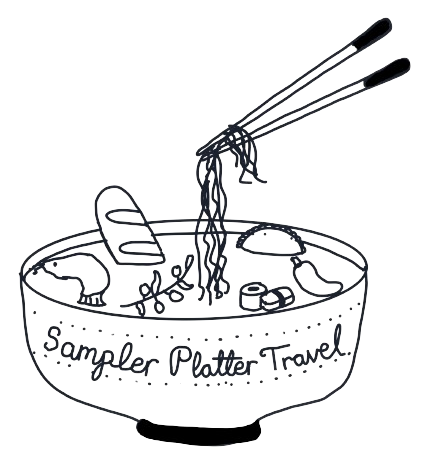Big Island Itinerary: 4 Days in Hawai’i’s Volcanic Paradise
By Daniella from Sampler Platter Travel – this guide to the Big Island contains affiliate links to trusted partners!
Looking for an adventurous and fantastic 4 day Big Island itinerary? This fast-paced guide takes you through hiking in volcanoes, snorkeling with manta rays, and everything in between on Hawaii’s beautiful Big Island. While given its name for being the largest island in the archipelago of Hawai’i, the Big Island has so much to offer, making it a paradise for all travelers.
This itinerary was tested and loved by my family and me when we visited the Big Island of Hawai’i a few Septembers ago. While Maui and other islands are rooted in relaxation, the Big Island is the place to go if you are interested in nature, hiking, and exploring Hawai’i’s insane biodiversity.
You could easily spend an entire lifetime on the Big Island, but to get a good taste, you only need four days. This gives you enough time to explore all sides of the island as well as the center, home to Hawai’i Volcanoes National Park.
Happy Sampling!
Not sure whether to visit the Big Island or Kauai? Check out our guide on The Big Island of Hawaii vs Kauai: What Island Should You Visit?
Top Tours on the Big Island, Hawai’i
- Night Manta Ray Adventure, 3,500+ 5 ⭐ reviews, from $94.00
- Big Island in a Day: Volcanoes Waterfalls Sightseeing and History, 4,500+ 5 ⭐reviews, from $242
- Mauna Kea Summit Sunset, 800+ 5 ⭐ reviews, from $269
- Big Island Zipline Over KoleKole Falls, 700+ 5 ⭐ reviews, from $220
- Guaranteed Dolphin and Whale Watch Tour in Kona, 100+ 5 ⭐ reviews, from $119
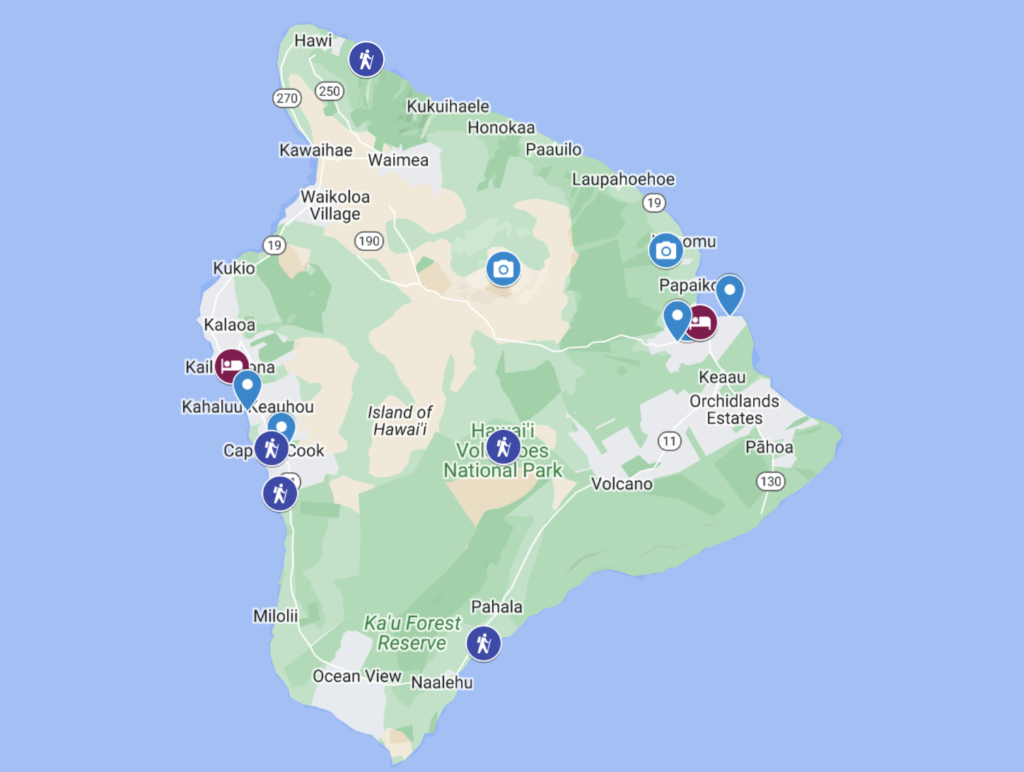
Big Island Itinerary at a Glance
Day 1
- Hiking in Volcanoes National Park
- Relaxing on Punaluu Black Sand Beach
Day 2
- Exploring the town of Hilo
- Entering the darkness of Kaumana Caves State Park
- Wandering around ‘Akaka Falls State Park
Day 3
- Learning about Hawaiian culture in Pu’uhonua o Honaunau
- Seeing the lively town of Kailua-Kona
- Experiencing the manta ray night swim
Day 4
- Taking a Kona Coffee tour
- Walking the Pololū Valley Lookout & Trail
- Stargazing at the summit of Mauna Kea



Table of Contents
Day 1 – Hiking in a Volcanic National Park & A Black Sand Beach
Lace up your hiking shoes today! It’s time to work those quads.
(1) Hike in Hawai’i Volcanoes National Park
Welcome to Hawai’i Volcanoes National Park, debatably one of the coolest national parks of the 63 in the United States. Of course, we are not discounting any of the others, but how many national parks have active volcanoes? Alright, fine, 37 of them, but still, it’s super cool.
Hawai’i Volcanoes National Park is a UNESCO World Heritage Site that is the home to Kilauea and Mauna Loa, two active volcanoes. While this entire four day itinerary could be dedicated just to Hawai’i Volcanoes National Park, spend today doing a full-day or half-day hike. At the end of the adventure, there will be an opportunity to relax on a nice beach.
Crater Rim Trail
Start the morning by doing part of the Crater Rim Trail. This trail is of varying lengths around the rim, but most people stop at one of the parking lot overlooks to view the crater floor from the top of the Kilauea summit. Experience the steam vents for a quick facial (don’t try this at home). In just a bit of time, we will be trekking to that same crater floor.
Kilauea Trail, 4 miles (6.4 km)
The best trail is the Kilauea Trail, a loop of 4 miles of moderate difficulty. If you only do one single hike in the national park, let it be this one. This necessary experience starts on the rim of the crater and descends 400 feet into the floor. Pass through a luscious green rainforest and enter what feels like the surface of the moon. The crater floor is made entirely of volcanic rock, with scattered flora throughout.
The entire route takes you from the top of the rim, down to the crater floor, and back up again on the other side. Given the slight incline entering and leaving the crater floor, the hike takes about two to three hours to complete.
Thurston Lava Tube, 1.5 miles (2.4 km)
The Thurston Lava Tube is a moderate 1.5-mile trail, making a great add-on to the Kilauea Trail. It begins at the Kilauea Iki Overlook. Explore the Thurston Lava Tube as a quick detour while you are completing the Kilauea Trail.
The Thurston Lava Tube is relatively short but allows you to walk through a 500-year-old lava tube. While there is no more hot lava flowing through it, it is still fascinating to visit. Flashlights are not needed for this experience, although it doesn’t hurt to turn on your phone’s light if you feel more comfortable doing so.
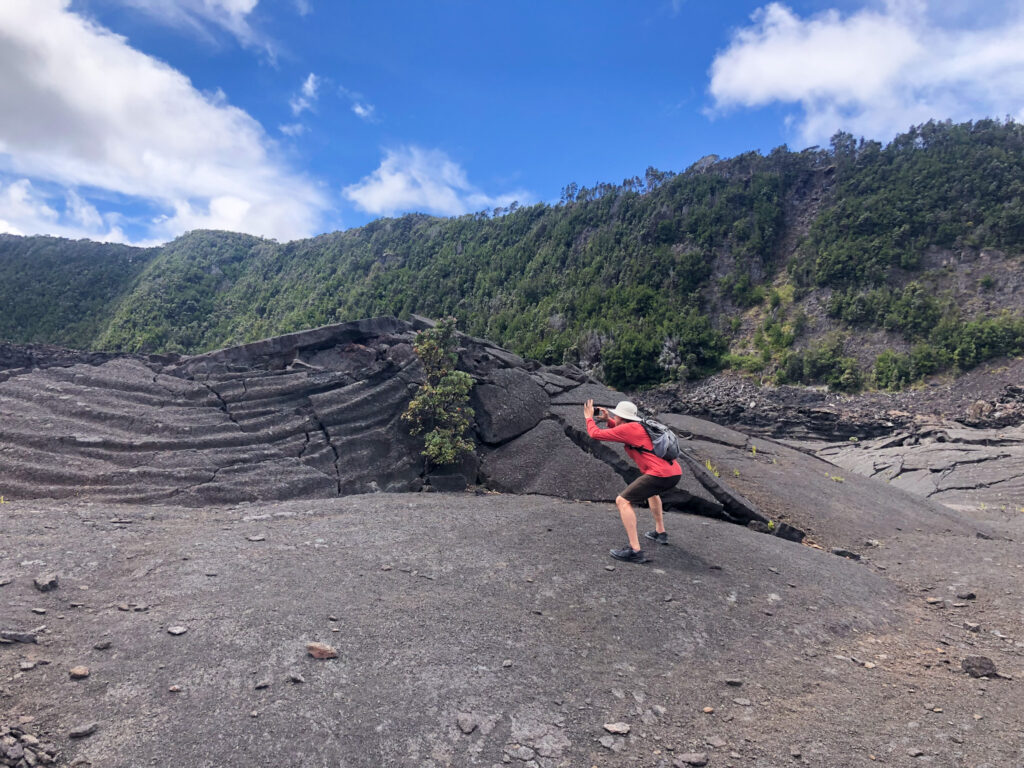
(2) Punaluu Black Sand Beach
After a long day of hiking, take a quick 30-minute drive to Punaluu Black Sand Beach. This beach is made more for relaxing than swimming. Due to the immense amount of rocks lining the shore, we suggest staying on the sand rather than attempting to dip in the ocean.
This beach is a great place to relax before heading back to your accommodation. As you might have guessed from the name, Punaluu Black Sand Beach does have black sand, making it a fascinating stop on your Big Island itinerary.
If you are lucky, you might be able to catch one of the resident sea turtles that call Punaluu Black Sand Beach home. Just remember to keep a safe distance from the wild animals and make sure to not disturb them. Have a bite to each at one of the cafes or walk around and go sea turtle spotting.
Once you’ve had your fix of black sand, head back to your hotel and relax before another long day tomorrow.
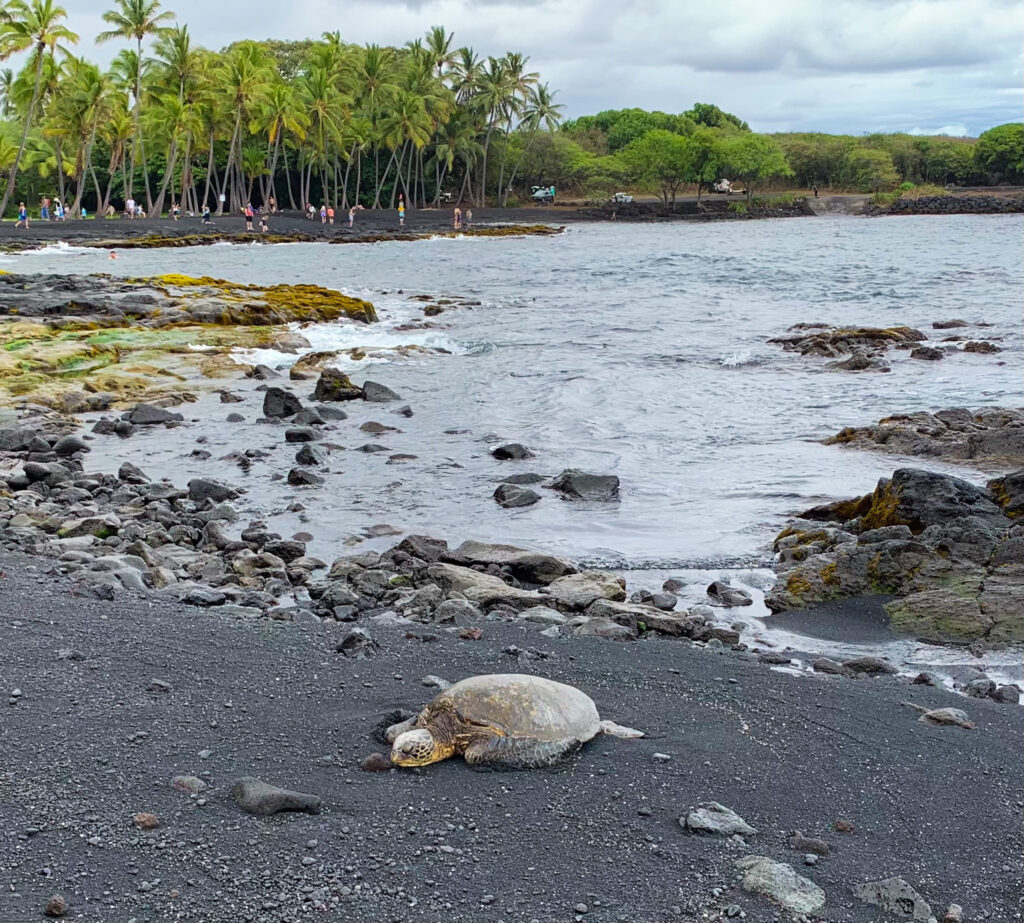
Day 2 – Exploring the town of Hilo, a Cave System, & ‘Akaka Falls State Park
(3) Town of Hilo
On day two of our Big Island itinerary, we are going to spend more time exploring the amazing town of Hilo. Hilo is a small city that overlooks the Hilo Bay. There are plenty of paved walking trails along the shoreline, as well as parks that are perfect for picnics. Hilo is not home to many sandy beaches, however, so note that most of the ocean will be alongside parks or rocky shores.
Hilo Activity #1 – Rainbow Falls
Start the day with one of the easiest nature-viewing experiences that you will ever have.
Rainbow Falls is located right in the town of Hilo. All you have to do is park your car, walk 100 feet, and see the Rainbow Falls from one of two overlooks. If you go early in the day, you will have the opportunity to see rainbows, hence its great name.
Seeing Rainbow Falls is a perfect activity for those who are winded from the long day of hiking yesterday at the Hawai’i Volcanoes National Park. It only takes 3 steps to see this natural wonder.
Hilo Activity #2 – Farmer’s Market
For a bite to eat, head over to Hilo’s fantastic open-air farmer’s market. Unlike traditional farmers markets that are only operational one or two days a week, Hilo’s is open all seven days from 7:00 AM to 3:00 PM. That being said, the biggest days are Wednesdays and Saturdays, when the market sees a ton more vendors than on the average day.
Hilo Farmer’s Market is a lovely place to experience locally grown food, roasted coffee, and exotic tropical fruit. The market supports local farmers and artisans, so if you want to buy a gift or souvenir, this is the place to go. On top of fresh fruits and vegetables, the farmers market has jams, baked goods, and a large craft section.
For the most popular item, don’t forget to grab some Hawaiian papaya. They are incredibly sweet and juicy, and 95% of them are grown on the east side of the Big Island near Hilo.
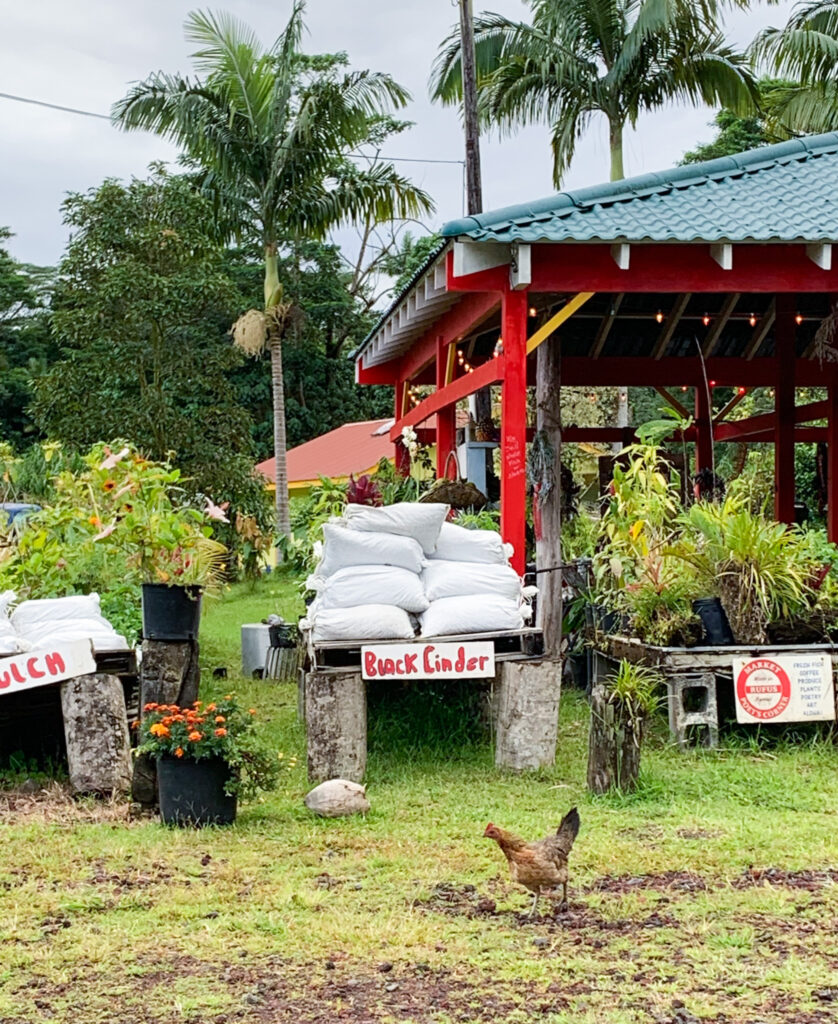
Hilo Activity #3 – Carlsmith Beach Park
After you’ve had your fix of eating good food at Hilo Farmer’s Market, head over to Carlsmith Beach Park which is a 10-minute drive away.
Carlsmith Beach Park does not have any sandy beaches, which is quite common for the Big Island of Hawai’i. However, it is an incredible place to snorkel and swim. Lava rocks keep the waves from getting too choppy, secluding the beach from the rest of the turbulent ocean. The lack of waves has kept the lava reef calm, leading to its flourishing biodiversity.
Given its close proximity to the town of Hilo, Carlsmith Beach Park is very accessible, and you will hopefully see some sea turtles during your swim.
(4) Kaumana Caves State Park
Next, drive around 20 minutes to Kaumana Caves State Park. This park recently reopened after being closed for four months following a rock fall near the entrance. Therefore, while it has opened again, visitors should be aware of the risks associated with exploring the cave.
Regardless, the Kaumana Caves State Park is worth a visit. There is no hiking involved as you can walk right into an old lava tube. Most of the tube is closed as it passes under private property, but you can enter a few meters into complete darkness. Make sure to pack a flashlight for this awesome experience.
Budget around 20 minutes at Kaumana Caves State Park to explore the mouth of the cave up to the turnaround point. A large trespassing notice will indicate when you must return to the entrance.
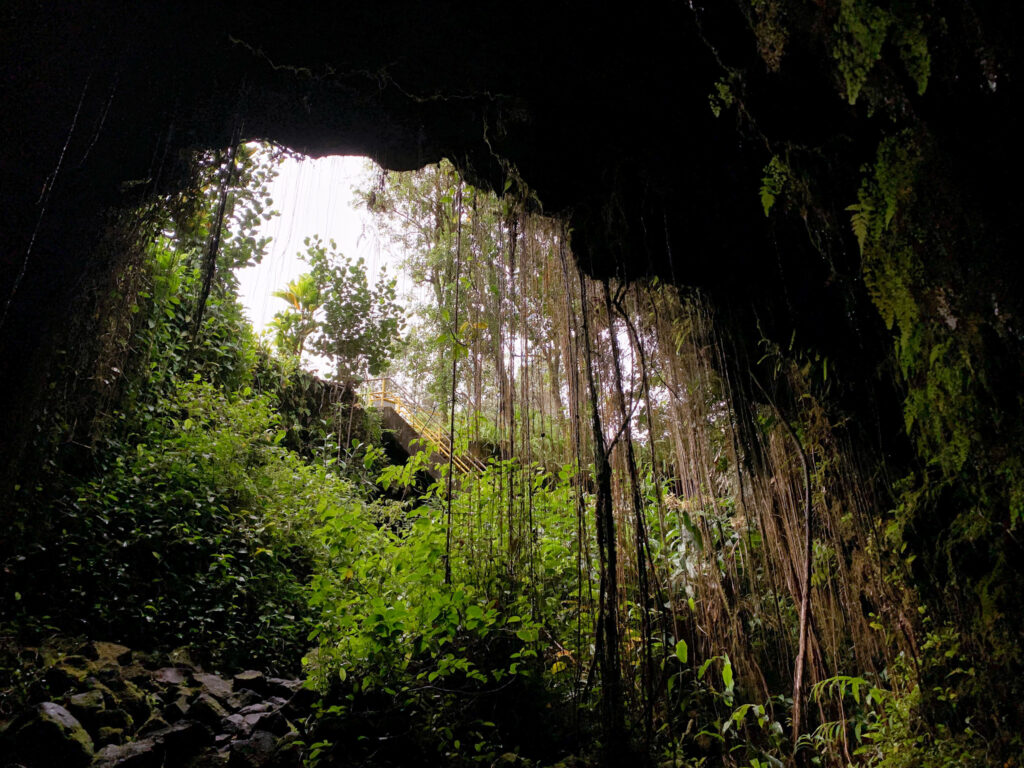
(5) ‘Akaka Falls State Park
Now, drive 35 minutes to ‘Akaka Falls State Park. This great little stop allows you to see two stunning waterfalls during a short walk – perfect for less active travelers.
For 5 USD, non-Hawaiian residents can have access to the state park. Do note, however, that there is a charge of 10 USD to use the parking lot.
‘Akaka Falls State Park is an easy walk, taking only 30 minutes to complete the 0.4 mile (0.64 km) loop. The walk is completely paved, so you can leave your hiking boots at home. Unfortunately, parts of the trail have stairs, so ‘Akaka is not wheelchair accessible. The convenient loop means you won’t get lost and see the two jaw-dropping waterfalls of ‘Akaka and Kahuna along the way.
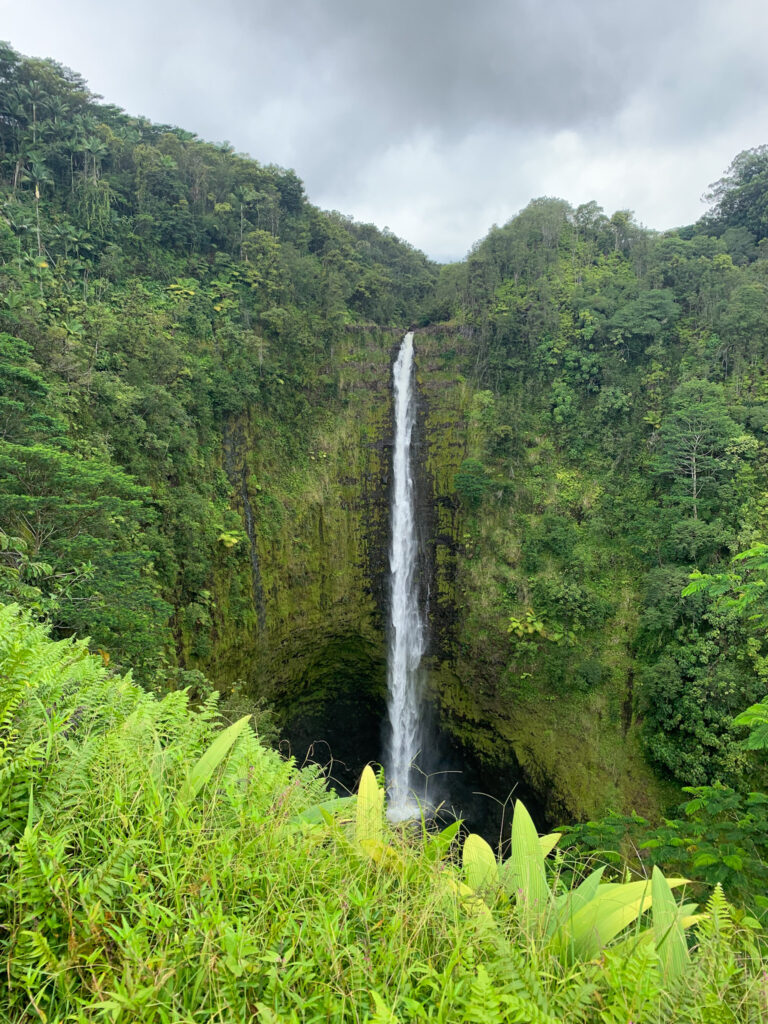
Day 3 – Kailua-Kona & the West Side of the Big Island
On day three of our Big Island itinerary, explore the west side of the island, starting at a historical park that holds sacred importance to native Hawaiians. Then, spend some time in Kailua-Kona, one of the liveliest towns on the island, before ending the night with a life-changing aquatic experience.
(6) Pu’uhonua o Honaunau
Pu’uhonua o Honaunau is an incredible place to visit and learn more about Hawaiian culture. This national historic park covers 180 acres and fully immerses you in ancient Hawaiian history. Pu’uhonu means a sacred place of refuge that was created as a safe place to escape breaking sacred laws (kabu). It holds historical as well as modern significance to the Hawaiian people.
We highly recommend taking a self-guided walking tour along the ancient royal grounds which were once part of the chiefdom of Kona. First, pass through the wall bordering the royal grounds to enter the pu’uhonu. This self-guided walking tour is only half a mile long, but for more information about the site, download the National Park Service app for an audio tour of the area.
On most Thursdays through Mondays, you may have the opportunity to visit Kahaka’io Ravenscraft, a cultural practitioner from the area who does traditional craftsmanship. He sits in a thatched structure and tells fantastic ancient Hawaiian stories to visitors.
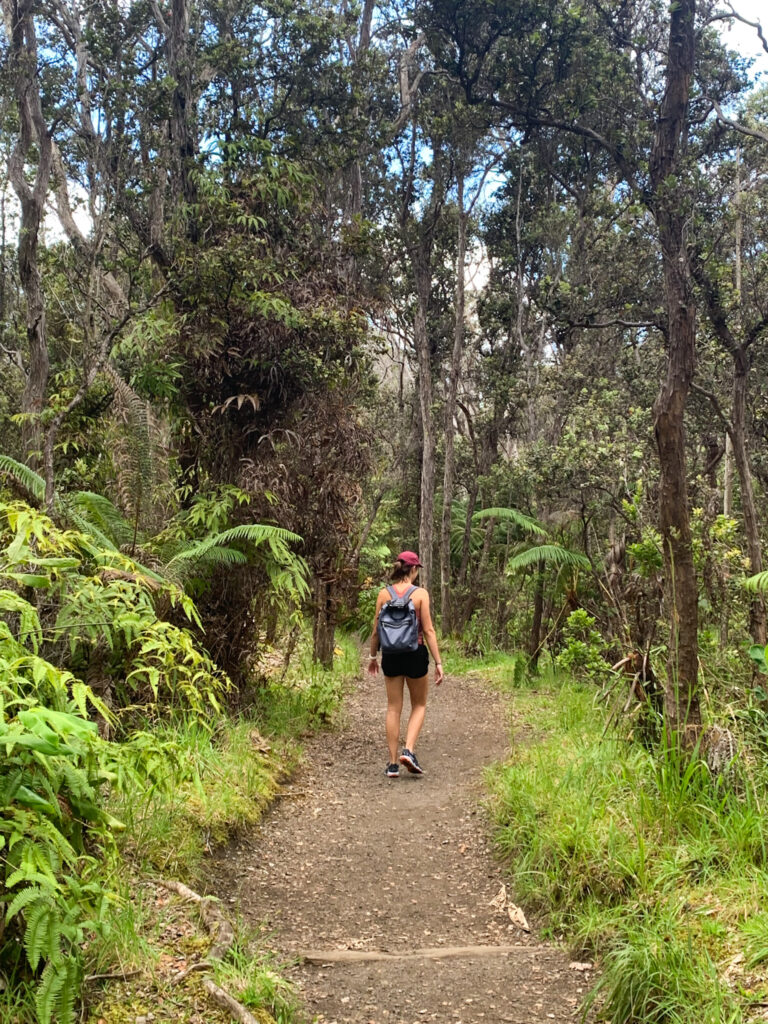
(7) Explore Kailua-Kona
In the afternoon, explore the town of Kailua-Kona, located a 45-minute drive south of Pu’uhonua o Honaunau.
Kailua-Kona, also known as Kona by the locals, is a relaxed town on the west side of the Big Island. It is a great destination for beach lovers as well as the location from which most boat tours depart from. This afternoon is a free day, but here are a few options for exploring the town:
- Take a whale-watching tour
- Relax on the beach
- Go to Kona Brewing Company. If you’ve ever tried one of their beers in other parts of the U.S., you should definitely see their brewery and taproom. Have a beer from the source!
- See a luau show
- Go snorkeling
- Hike the Captain Cook Monument Trail – quite a difficult experience!
The Captain Cook Monument Trail is highly regarded as one of the best hikes in Hawai’i, although it is incredibly difficult.
The monument itself is a 27-foot (8.2 meters) tall obelisk marking the spot where Captain Cook died.
However, the adventure lies in getting to the monument as opposed to the obelisk itself. The closest that you can drive to the monument is 1 mile (1.6 km) away, meaning that getting there can only be done via boat or by taking a strenuous hike down to the beach.
The 3.7-mile (5.9 km) out-and-back hike takes an average of 2.5 hours to complete (not including the much-needed snorkeling time). If you choose to take the trek, you must pack your snorkeling equipment. Cooling down and having fun will be very necessary after the hike.
If you choose to attempt the Captain Cook Monument Trail, this should be the only activity you do in Kailua-Kona, as time will be tight. For those who don’t want to attempt the hike, there are also boat tours that head to the monument.

(8) Manta Ray Night Swim
After you’ve had your choice of adventure or relaxation in Kona, head to the Honokōhau Marina, 10 minutes from the center of the city.
The manta ray night swim is an experience that everyone needs to have on the Big Island, as you will not encounter it anywhere else in the world. The 3-hour boat tour departs from the marina, taking around 30 minutes to sail to the manta ray viewing location off the coast of Kona.
Once there, get up close and personal with the insanely large manta rays. Boat operators turn on lights attached to a raft, attracting plankton, in turn bringing the manta rays to the surface of the water.
The tour includes snorkels, which you will use to breathe while holding onto the raft and staring down at the ocean floor below. In just a few minutes, manta rays will come close to the light and surface. The manta rays will open their mouths to eat the plankton, but don’t worry, they are completely harmless.
The manta ray night swim is a fascinating experience. You might get a bit queasy in the water (I may have vomited), but it is absolutely worth every second. As you spend the entire time submerged in the water, the best time of year to go is during the summer to avoid hypothermia.
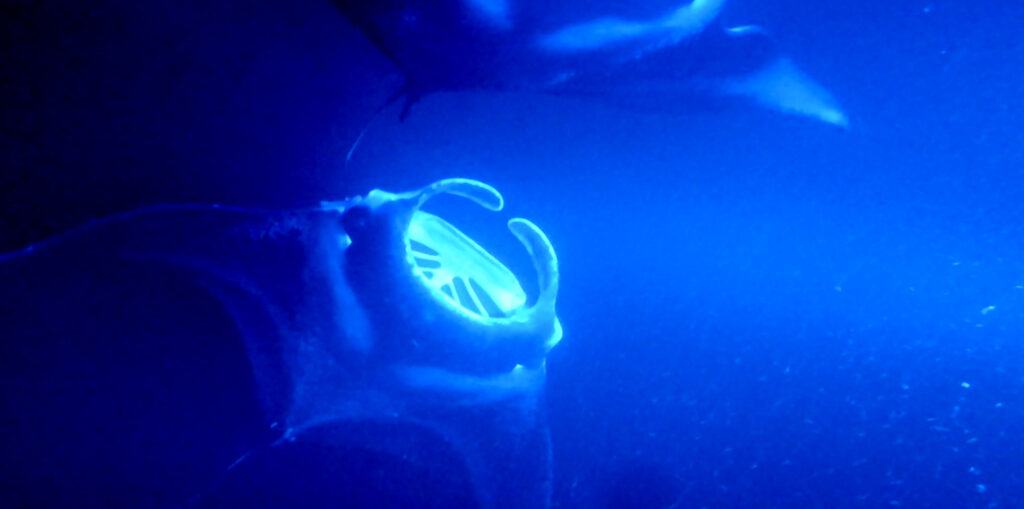
Day 4 – Taking a Kona Coffee Tour & Summiting the Mauna Kea Volcano
On the last day of our Big Island itinerary, have some much-needed coffee, admire a stunning overlook, and drive to the top of a volcano to view the sunset and go stargazing.
(9) Take a Tour of the Hala Tree Coffee Plantation
There is no better way to start the day than with a mug of fresh coffee. Kailua-Kona is known for having some of the best coffee in the entire world. Kona-style coffee is from this region of Hawai’i, known for its strong and nutty flavor notes.
While there are tons of coffee tours, Hala Tree Coffee has a fantastic free one-hour-long tour of their plantation. They practice sustainable agriculture and are certified USDA organic, so you’ll know that you are supporting the right farmers.
For those who are extra interested in coffee, Hala Tree offers roasting tours for 20 USD per person, allowing visitors to take a hands-on roasting class. If you are really passionate, take the skills you learned in Hawai’i back home with you to become the neighborhood’s friendly hobby coffee roaster.
Coffee plantation tours are a great way to see how Hawai’i’s agriculture has changed throughout history, leading to the production of world-class beans in today’s day and age. Coffee fans will need to make extra space in their suitcase for a massive bag of whole beans.
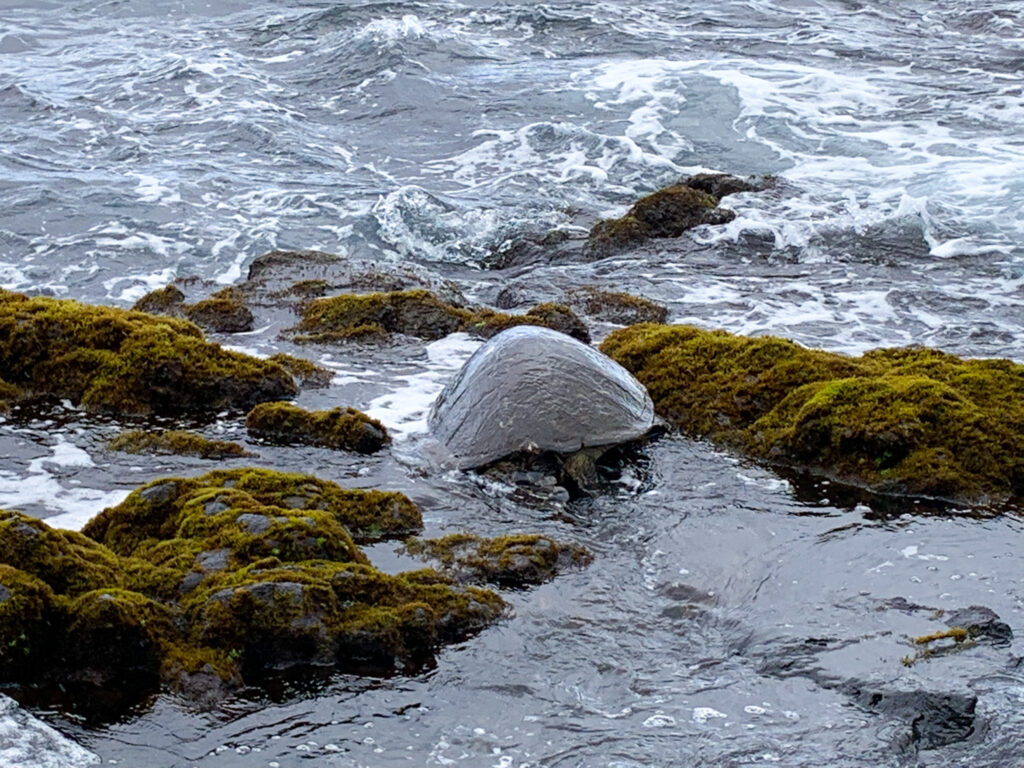
(10) Pololū Valley Lookout & Trail
After you’ve had your fix of coffee drive 1 hour and 40 minutes to the Pololū Valley Lookout & Trail. It might sound like a long drive, but it’ll only be the second-longest today ?
The Pololū Valley Lookout & Trail is located along the Northern (Kohala) Coast. In this destination, you can either park at the lookout and snap a quick photo, or hike down the hillside. If you’re lucky, you might be able to spot a few horses grazing in the Pololū Valley.
If you look further down, you’ll be able to see the black sand beach, which is reachable by a 25-minute hike. While you are only descending 0.6 miles (0.96 km), it is quite steep, making it much harder to trek back up.
Note: the ocean is not a safe place to go swimming. There is a massive undertow that will pull swimmers under the water. While you can dip your feet in for a quick cool-down, don’t submerge yourself in the ocean.
(11) Stargazing at Mauna Kea
Finally, end of the day by heading up to Mauna Kea, approximately 2 hours away, into the heart of the island. This dormant volcano offers the best stargazing opportunities in all of the Big Island. The Visitor’s Center is located a whopping 9,200 feet (2,804 m) above sea level. Don’t worry – you won’t have to hike up the volcano to get to the Visitor’s Center as it is accessible by car via paved roads. Plan your trip accordingly so you can both view the sunset and stargaze at the Visitor’s Center.
Even more adventurous travelers can head up to the summit and view the sunset from further up. This option is only available in guided tours on 4 x 4s, as you cannot take your own rental car up the side of the volcano.
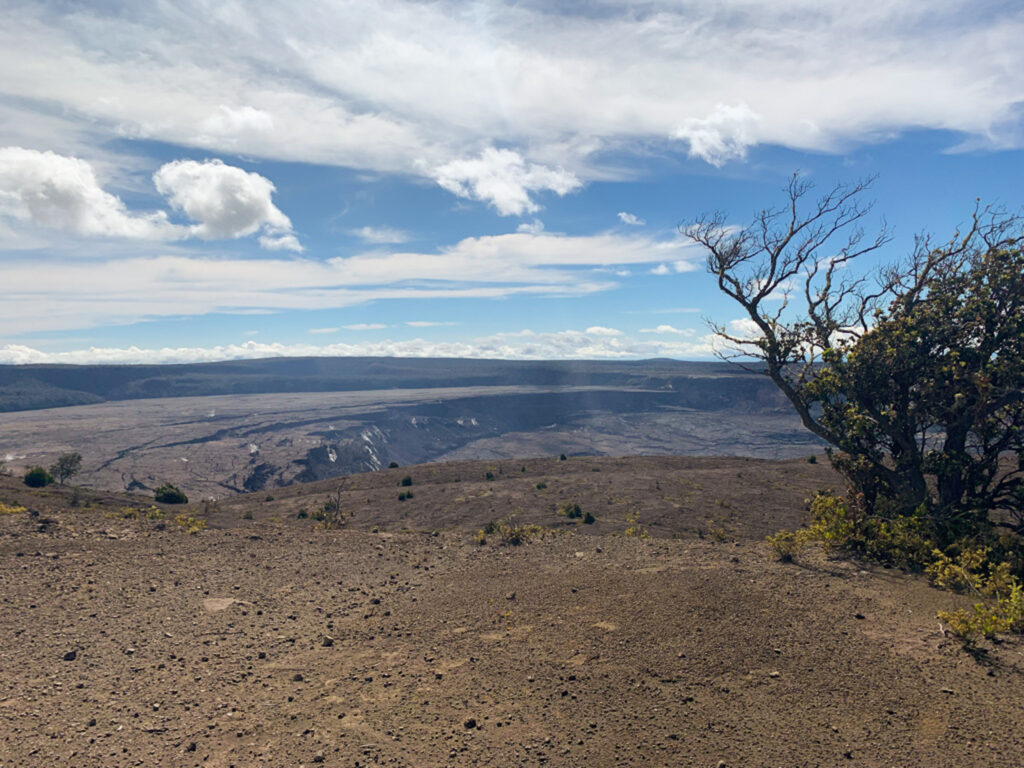
General Tips About the Big Island, Hawai’i
- Trail runner shoes are just fine – if you are wondering whether to pack your big hiking boots or your trail runners, feel free to pack your trail runners. Unless you are going to do a multi-day hike in Volcanoes National Park, regular trail runners work for an average day hike. The toughest hikes are down to shorelines and crater floors.
- Rent a car – you’re going to hear this one a lot in this particular blog, but we cannot stress it enough: getting a rental car is so important to explore the Big Island. Rental cars give you the flexibility to explore the island at your own pace, and it means that you don’t have to find dedicated tour groups. This way, you can find off-the-beaten-path excursions!
- Don’t be afraid to see a couple of cockroaches – I know that no one wants to hear this, but Hawai’i is a tropical paradise and bugs love paradise as well. While everything might look pretty and sunny on TV (and that is certainly the case in real life), Hawai’i does come with a few different bugs. Don’t be surprised to encounter a couple of cockroaches during your stay, especially if your hotel or Airbnb has an open veranda. Island cockroaches are big, but just mentally prepare yourself to see them.
- The Big Island of Hawaii is not the place for sandy beaches – yes, Hawai’i has so many islands with beautiful white sand beaches, and while the Big Island has a couple, it mostly has rocky beaches with water that is oftentimes not safe to swim in. That being said, Kailua-Kona is a town with gorgeous white beaches. If you want more than just a couple of options, add the islands of Maui and Oahu to your itinerary to get your fix.
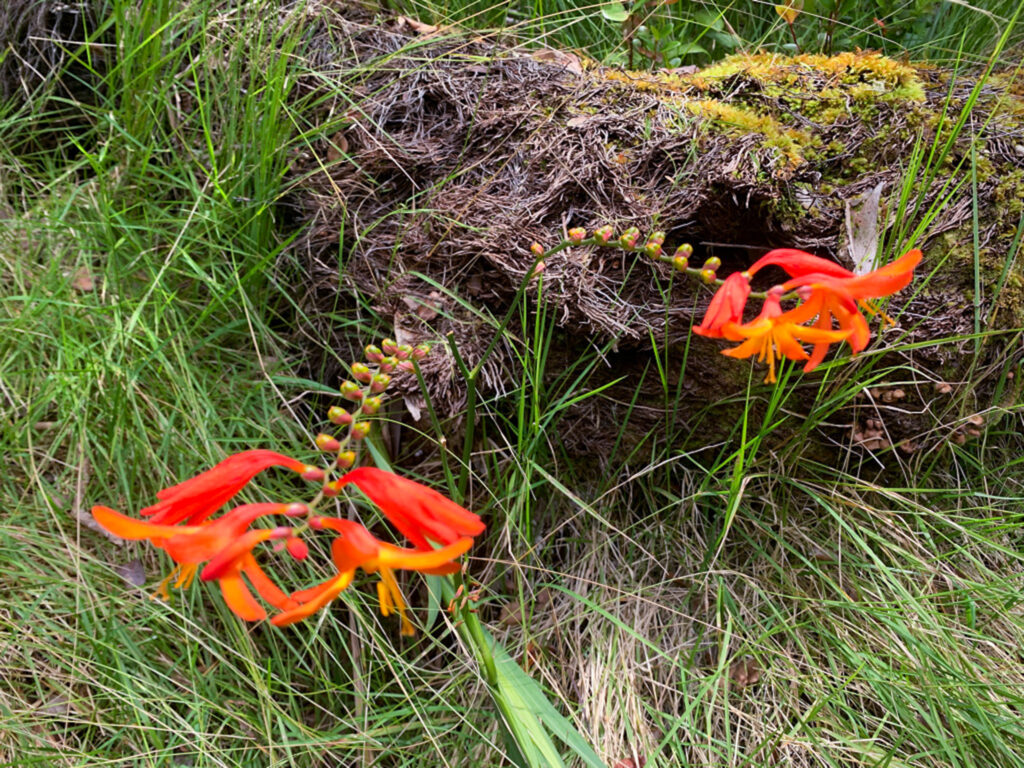
Where to Stay on the Big Island
On the Big Island of Hawai’i, the two towns of Hilo and Kailua-Kona take the cake for being the best in terms of accommodation options.
Hilo, on the east side of the island, has a rainforest climate with fantastic hiking and an outdoorsy vibe.
Kailua-Kona, on the west side of the island, is perfect for travelers who want a dry climate and are interested in relaxing on the beach.
Both towns have accommodations for all budgets and group dynamics.
Hilo
Our top choice for accommodations on the Big Island is Hilo. It is right near the airport and is a beautiful vibrant town with many restaurants and opportunities to relax between your adventures. The view of Hilo Bay is unbeatable, making for a great place to hang out and take a walk.
Luxury Hotel: Paradise Breeze Retreat, 11.2 miles from the city center, 9.5 stars
Mid-Range Hotel: Guest House in Hilo, 0.8 miles from the city center, 9.5 stars
Budget Hotel: The Big Island Hostel, 0.7 miles from the city center, 8.7 stars
Kailua Kona
Kailua Kona is another great option. This seaside town has a laid-back feel and is the home to the manta ray night swim, making the tour incredibly convenient. If you are only staying on the Big Island for a couple of days, this is a lovely town for you.
Luxury: Waterfall House – Hawaii, 5.2 miles from the city center, 8.7 stars
Mid-range: Aston Kona By The Sea, 2.1 miles from the city center, 8.5 stars
Budget Hotel: Alii Villas Condominiums, 1.6 miles from the city center, 7.2 stars

How to Get Around the Big Island
We recommend renting a car to explore during your Big Island itinerary. While it is the largest island in the archipelago, it is still relatively small, measuring 95 miles (152 km) long and 80 miles (128 km) wide. Having a car will give you a lot of flexibility to explore the island at your own pace.
The best way to get to the Big Island is to fly from Honolulu to Hilo, a large city on the east side. The flight is only 55 minutes, so you won’t even need to pull out your book. Once here, make sure to have a rental car reservation as cars are in high demand and limited supply.
What to Eat During Your Big Island Itinerary
Similar to the wonderful foods you must try in Kauai, the Big Island has fantastic dishes of its own.
- Loco Moco
This mouth-watering dish traditionally features white rice with a hamburger, fried egg, and brown gravy. Many variations include spam, fish, tofu, chicken, or other meats, but regardless of what combination you get, you will love the loco moco.
- Kona Coffee
Kona coffee is well-known around the world for having a smooth and nutty flavor. When on the Big Island, you must try this coffee from the source. Don’t forget to grab a massive bag of beans to take back with you on the plane.
- Malasada
An originally Portuguese snack, malasada was brought to the island of Hawai’i in the 19th century and has been a well-loved addition to the cuisine ever since. This fried donut is frequently filled with flavored custard, chocolate, or guava sauces.
- Açai Bowls
While açai bowls are available everywhere, they add more magic to a Hawaiian morning. This smoothie bowl is made from açai berries and combined with bananas, granola, and other toppings to create a nutty and fruity creation. You can’t go wrong with an açai bowl.
- Poke
Yes, this was also on the Kauai list, but it’s because it’s so popular, and you have to try it in both locations! Poke is a dish with raw fish served either as a side or a main. They include other toppings such as pineapple, avocado, and more, and are very customizable. In Hawaii, they are most commonly served as a side dish.

Frequently Asked Questions About a 4 Day Big Island Itinerary
-
How many days is enough for Big Island?
While the Big Island has so much to explore, the gist of what it has to offer can be seen in four days. This allows you to see one of the four sides roughly every day and lets you relax and take your time throughout your exploration.
-
What should you not miss on the Big Island?
If you absolutely had to prioritize what to see on the Big Island, there are two activities you have to add to your list. The first is taking a hike in Volcanoes National Park around the crater, and the second is doing the manta ray night snorkeling tour. Both of these activities are incredibly unique, found nowhere else in the world. With a bit more time, we suggest heading to Mauna Kea and summiting to see the sunset and go star gazing.
-
What is the best month to visit Big Island?
The best months to visit the Big Island are from March and September when you’re able to enjoy the beach with the least amount of rain. We went in the middle of the summer and realized that the heat was not as bad as we had expected. Traveling to tropical destinations during the summer is usually counterintuitive, but in this case, it’s a great option so that you can warm up a little bit and enjoy the water and the beach. The Big Island of Hawai’i is known for water activities such as the manta ray night swim, so you’ll want to go during the summer months when the water has warmed up.
-
How to do the big island in 4 days?
The most efficient way to do the Big Island in four days is to split it up by region. There are generally four sides to the Big Island (South, North, East, and West). If you take one day to explore each of the four zones, you will be efficient with your itinerary. That being said, the Big Island is only 95 miles long and 80 miles wide. The small size (of the Big Island!) makes it easy to drive across and experience all the must-see sites.
-
If you had only 3 days to stay in Hawai’i, where would you go?
If you only have three days in your Big Island itinerary, we would suggest prioritizing the Volcanoes National Park on one day, the Kailua-Kona area with the manta ray night snorkeling on the second, and the Hilo area on the third. There are unforgettable experiences to have on the Big Island of Hawai’i, making it such a fantastic destination.
We hope you enjoyed this fast-paced 4 day Big Island itinerary. Hawaii’s Big Island is often overlooked for the romantic and beach-friendly destinations of Honolulu and Maui. I personally think that the Big Island is one of the coolest places on the planet and should be on everyone’s travel bucket list. A few days in the Big Island is a perfect addition to 4 days in Kauai and a quick layover in Honolulu. It is a necessary North American destination to visit in your lifetime.
Happy Sampling!
